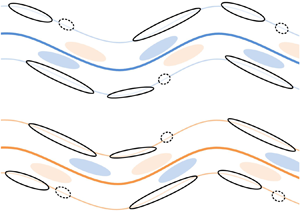Article contents
Energy transfer structures associated with large-scale motions in a turbulent boundary layer
Published online by Cambridge University Press: 13 November 2020
Abstract

The role of large-scale motions (LSMs) in energy transfer is investigated by analysing wall-parallel velocity fields at low-to-moderate Reynolds number ( $Re_{\tau }=1200\text {--}3500$), which are obtained via a two-dimensional (2-D) particle image velocimetry measurement with large field-of-view. Two types of energy flux, i.e. local interscale energy flux and in-plane spatial energy flux are inspected in detail. Targeting the energy transfer in large-scale regime, an anisotropic filter is designed based on the zero-crossing scale boundary in a 2-D energy transfer spectrum, across which the net energy flux is the maximum. This ‘optimal’ energy flux boundary separates the scale space into an energy donating large-scale part and an energy receiving small-scale one. The crossover energy flux, as well as the associated flow field structures, are studied by conditional statistics and linear stochastic estimation, in which the statistical spanwise symmetry is deliberately broken by designing special velocity gradient conditions for event probing. A strong connection between large-scale energy flux events and LSMs are found. Namely, forward scatter events have higher probability to reside on the wavy flank of low-momentum LSMs, if compared with the scenario of being clamped in the middle of two streamwise-aligned high- and low-momentum LSMs (Natrajan & Christensen, Phys. Fluids, vol. 18, issue 6, 2006, pp. 299–325). Meanwhile, pairs of positive and negative spatial transfer events tend to locate inside LSMs. It is thus argued that the meandering nature of LSMs, which forms the necessary velocity gradient, might play a determining role in the process of large-scale energy transfer. The spatial correlation between them is then schematized in a conceptual model, which explains most of the present observations.
$Re_{\tau }=1200\text {--}3500$), which are obtained via a two-dimensional (2-D) particle image velocimetry measurement with large field-of-view. Two types of energy flux, i.e. local interscale energy flux and in-plane spatial energy flux are inspected in detail. Targeting the energy transfer in large-scale regime, an anisotropic filter is designed based on the zero-crossing scale boundary in a 2-D energy transfer spectrum, across which the net energy flux is the maximum. This ‘optimal’ energy flux boundary separates the scale space into an energy donating large-scale part and an energy receiving small-scale one. The crossover energy flux, as well as the associated flow field structures, are studied by conditional statistics and linear stochastic estimation, in which the statistical spanwise symmetry is deliberately broken by designing special velocity gradient conditions for event probing. A strong connection between large-scale energy flux events and LSMs are found. Namely, forward scatter events have higher probability to reside on the wavy flank of low-momentum LSMs, if compared with the scenario of being clamped in the middle of two streamwise-aligned high- and low-momentum LSMs (Natrajan & Christensen, Phys. Fluids, vol. 18, issue 6, 2006, pp. 299–325). Meanwhile, pairs of positive and negative spatial transfer events tend to locate inside LSMs. It is thus argued that the meandering nature of LSMs, which forms the necessary velocity gradient, might play a determining role in the process of large-scale energy transfer. The spatial correlation between them is then schematized in a conceptual model, which explains most of the present observations.
Information
- Type
- JFM Papers
- Information
- Copyright
- © The Author(s), 2020. Published by Cambridge University Press
References
REFERENCES
- 22
- Cited by


